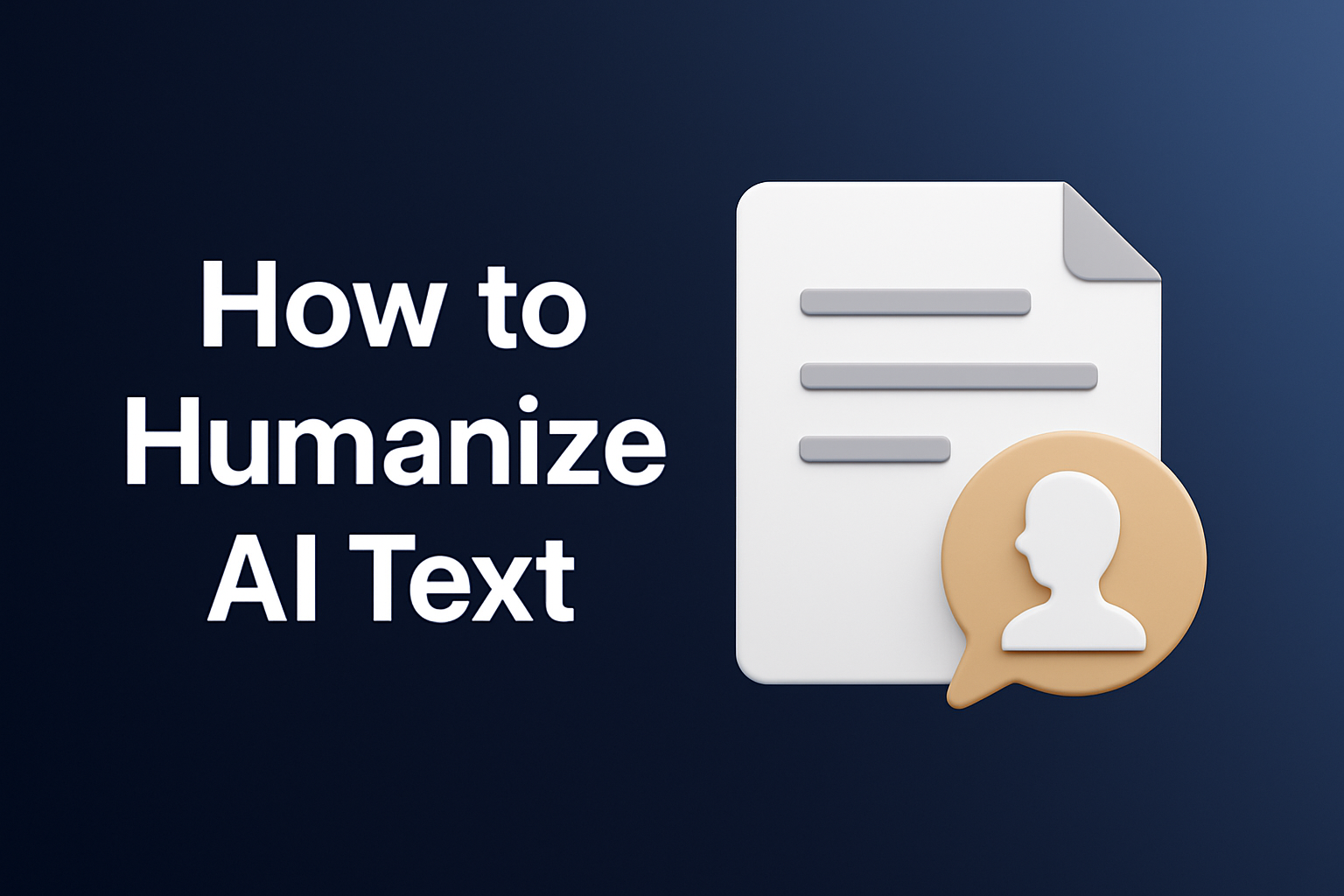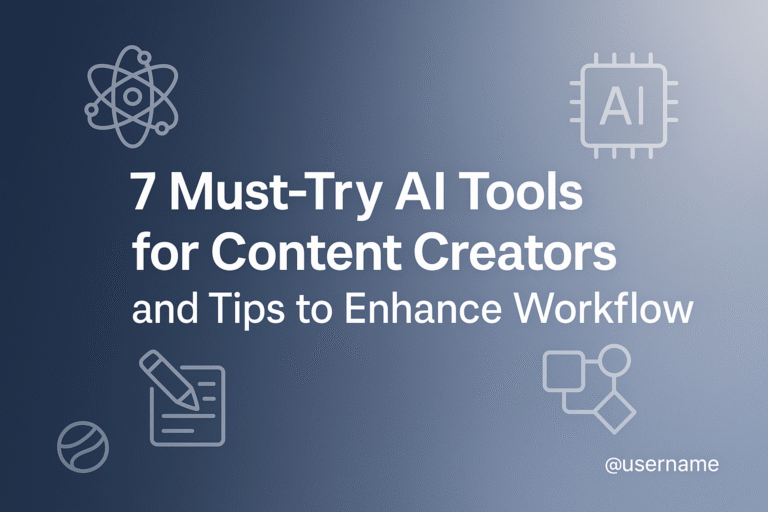9 Tips on How to Humanize an AI Text for Natural Results
More than 80% of marketers say AI-written drafts need a big edit before they feel right. With Google’s latest update cracking down on thin, AI-generated content, knowing how to humanize AI text isn’t just a nice-to-have—it’s a must.
Adding a human touch grabs attention, keeps people reading, and helps your content rank higher. So, let’s dive into real steps that make AI writing feel natural and genuine.
Why Humanize AI Text?
Most AI tools spit out copy that sounds correct but often misses the mark emotionally. Google now uses its algorithms to sniff out robotic writing and will lower your page rank if it thinks your content is “factory-farmed.” 82% of marketers say AI drafts need heavy editing just to sound human.
When you layer in personal stories or add real examples, you get a 37% boost in how long people stay on your page. Even quick team chats or voice notes can help collect those “human” angles AI misses.
This matters because people can spot and tune out flat, generic content fast. Humanizing your AI text builds trust, helps you stand out in search results, and leads to better engagement every time. Understanding how to humanize AI writing can significantly enhance the quality of your content.
1. Consider the AI Text as a First Draft
When you get an AI draft, treat it like a rough first pass, not something you can publish as-is. Most content managers (71%) say they use AI as a “raw base”—never the final word.
Copying and pasting straight from AI makes your brand seem lazy and can even hurt trust. A simple test: Read your draft out loud. Listen for weird pauses, clunky phrases, or anything that just sounds “off.” Manual edits after AI raise trust with readers by 40%.
AI is a good brainstorm buddy, but you’ll always need a human eye to shape the final story. If something feels robotic, change it. That’s how you end up with writing that feels alive, not like it came from a machine.
2. Personalize the Text with Stories and Emotions
Personal stories pull people in. AI doesn’t know what it’s like to struggle with a deadline or feel nervous before a big meeting. But you do.
When you swap a bland line like “There is not enough staff” for “There’s no one to take your father for his daily walk,” the content clicks with readers. Using the 3-E Rule: Empathy, Example, Emotion—makes your writing stand out.
- Emotional content gets shared twice as much and builds trust with 61% of readers.
- Drop in quick anecdotes, even simple ones like “Last week, I saw…”
These touches make the writing feel like it’s coming from a real person, not a bot. Aim for this in every section and watch how much stronger your content becomes. Tips from an AI writing improver can assist in refining this process.
3. Watch Your Tone of Voice
A steady tone of voice builds trust and helps your brand stick in people’s minds. AI often writes in a bland, middle-of-the-road style. Sometimes it mixes formal and informal language, which confuses readers.
Over half of content teams say fixing “off-tone” writing is their top edit after using AI. To keep your tone right, use a sample paragraph from your best work and ask the AI to match that style.
Treat it like you’re chatting in Slack, not writing an old-school whitepaper. Consistency matters because companies with a steady voice see 33% more people come back for more. Don’t be afraid to put your own spin on things; it makes your writing feel more welcoming and real. Engaging with an AI writing reviewer can provide valuable feedback to maintain consistency.
4. Add Humor
Humor makes content memorable. But here’s the thing—AI just isn’t funny. Only 16% of AI tools can toss in a joke that doesn’t sound forced or awkward.
A clever pun or pop-culture nod breaks up the bot-voice. Don’t worry about being a stand-up comic; even a little humor helps. Try doing a special “joke pass” when you edit. Make one round where all you do is look for places to add something light or playful.
According to the Harvard Business Review, humor makes readers remember your message 35% more. And even a cheesy joke signals to your audience that there’s a real person behind the words.
5. Edit Text Structure
AI loves to write big walls of text and repeat the same patterns. That’s tough on the eyes and the brain, especially on mobile.
Human editors break things into shorter paragraphs, bullets, and subheadings. Mobile readers are almost 50% more likely to finish articles that are structured well. Use apps like Hemingway or Grammarly to highlight dense spots and break up those giant blocks.
Throw in some lists, pull-quotes, or bold questions. This variation not only makes content easier to read but also keeps people moving down the page. Edit for active voice and change up your sentence lengths—short, then long. It creates a rhythm that feels more like a conversation.
6. Format Your Articles
Formatting is more than just looks—it shapes how people use your content. Good formatting (like headings, lists, and visuals) earns almost 30% more backlinks.
Add custom images, infographics, or even a quick checklist. Make sure you use white space so the page doesn’t feel cramped. Think about “pattern interrupts”—little surprises like a Q&A box, a callout, or even a funny gif.
Accessibility tweaks, such as clear structure and alt text for images, help all readers and boost engagement by 22%. Never trust the AI to format for you. Go beyond the basics and give each article your own touch.
7. Check the Facts
AI is known for making up facts or twisting data. In 42% of cases, marketers spot at least one factual error in every five AI-written articles.
If you publish unchecked AI stats, you risk losing trust and even spreading misinformation. Run a fact-check on every claim, link, and number. Use browser extensions like NewsGuard to speed up your review. Double-check stats by Googling the source.
This cuts down on embarrassing corrections by 67%. If you’re not sure about a detail, leave it out or get confirmation elsewhere. Your readers will thank you for accuracy.
8. Check Weird Expressions
Have you ever seen a phrase like “They listened with a hawk’s eye” and thought, “Wait, that’s not right”? AI sometimes mixes up idioms or uses strange language that real people wouldn’t say.
Editors say weird phrases are a big giveaway that AI wrote something. Trust your gut. When something sounds odd, fix it.
Read your content out loud and use a “banned phrase” list to spot common offenders. If you cringe at a line, your readers will, too. Smooth, everyday language builds credibility and helps your content connect.
9. Use Humanizing Software
You don’t have to do all this alone. Humanizing tools like Textmetrics spot stiff language, flag repetitive patterns, and suggest how to fix tone and structure.
Two-thirds of content teams use these “AI de-robotizers” weekly, and 73% say it cuts their manual editing time. Paste your first AI draft into a tool like Textmetrics. Let it do an automated pass. Then, do a final human check to polish things up.
These tools also help with SEO, making sure your content ranks well and feels good to real readers. Layer software with human editing for the best results.
The Benefits of Using AI Humanizing Tools
When you bring in tools like Textmetrics, you save time and boost quality. Teams using these tools report 50% fewer readability complaints and a 44% jump in consistent tone across articles.
You can set your house style and even block phrases you don’t want. Best part? The tools “bake in” your guidelines, so even rushed drafts come out sounding just the way you want.
That means less stress, faster workflows, and content that stands out both online and with your audience.
FAQ: How to Make AI Writing Sound More Human
What does it mean to humanize AI writing?
Editing AI text so it sounds natural, emotional, and real—like a person wrote it.
Do I always have to rewrite AI drafts?
Usually. Over 80% of marketers find edits are needed to fix tone and flow.
What’s the fastest way to make AI text sound human?
Add stories, adjust the tone, break up long blocks, and use a humanizing tool.
Are humanizing tools like Textmetrics worth using?
Yes, most teams save time and get more natural-sounding results with them.
How do I check if an AI made a mistake?
Fact-check every claim, scan for weird phrases, and trust your editorial instincts.
Will Google penalize AI-written content?
Only when it’s thin or unoriginal; how to humanize AI writing steps protect your rankings.
Can humor and emotion really boost engagement?
Yes. Humor increases recall by 35%, and emotional content doubles social shares.







